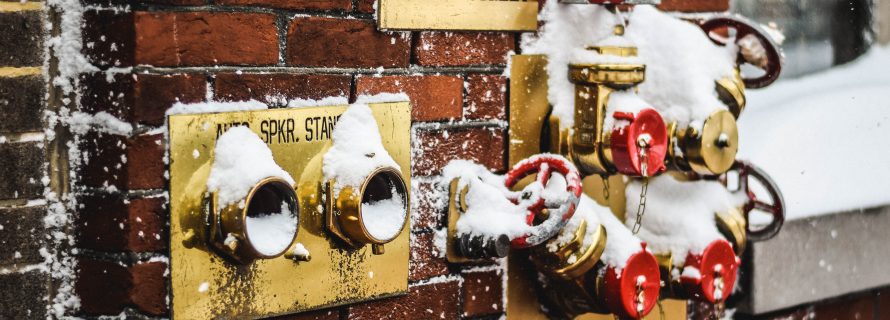How to Deal with Frozen Pipes Before they Burst and Cause Water Damage

Residential flooding can be attributed to several causes—heavy rainfall, clogged sewer lines, and leaking water heaters, to name a few. However, one of the most common causes of water flooding at home is a frozen water pipe.
Along with other malfunctions, freezing temperatures may cause cracks to form in the water connections, pipes, and valves. Before you know it, your property has sustained significant water damage, and you will need water damage restoration to fix things up.
When it comes to the most severe winter threats, frozen pipes are considered one of the most dangerous. It is also one of the most costly. Since water expands as it freezes, it puts significant pressure on the pipes until the pipes cannot hold the ice any longer.
If you turn on the faucet and get only a trickle of water, you can determine if the pipes are frozen early enough so you can thaw them just in time. Unfortunately, if you miss the warning signs, the result can range from a hairline crack to something that might match the pipe’s length.
The types of plastic or metal pipes that are more susceptible to freezing include swimming pool supply lines, outdoor hose bibs, and water sprinkler lines. However, indoor plumbing is not safe as well.
Frozen pipes that have cracks might burst indoors and cause massive water damage within hours of thawing out. Untreated leaks in walls, floors, cabinets, and so on can also cost thousands of dollars to clean up and repair. It might also lead to mold and mildew growth.
Why Pipes Freeze
When it gets cold, the accumulated water inside the pipes freezes, expands, and causes extreme pressure. Eventually, the ice creates too much pressure and causes the pipes to crack.
Here’s something not many people know: a one-eight-of-an-inch crack in a pipe can already release as much as 250 gallons of water a day! That amount of water is already enough to cause massive property and structural damage.
Below are some of the ways you can deal with frozen pipes, so they don’t burst:
Ensure the pipes are insulated
Even in warmer climates, exposed pipes are prone to freezing. Fortunately, there are various ways you can keep your pipes snug. One way is to add insulation pipes around your home. Protect your pipe from cold temperatures by wrapping the foam around your pipes.
Other ways you can keep your pipes warm include wrapping them using heat tape. You can also use thermostatically controlled heat cables.
Allow your faucet to drip
Allowing your faucet to drip can seem counterproductive at first glance. However, allowing your faucet to drip just a little bit is considered a smart and practical move during the cold winter months. Allowing water to drip can help ensure the pressure in the pipes is kept low. Low pressure also means there is a reduced chance of your pipes bursting.
Seal up leaks and cracks
During winter, caulk can be your best ally. It makes complete sense to keep as much of the cold air as possible. Conduct a careful inspection of your home and check if there are any air leaks.
Places to look include electrical wirings, drying vents, windows, and of course, pipes. Use a standard caulk gun to seal up the leaks and keep the chill out.
Pay close attention to your thermostat
If you are heading out of town, ensure the heat is set to no lower than 50 degrees Fahrenheit. While this can seem impractical, it is in reality, a wise move. You will not only be able to save a significant amount of money in the long run if you keep your house warm and avoid leaking pipes. Keep in mind that water damage can cost thousands to repair.
Shut off or disconnect the water
If you are out of town for a bit, consider draining your water system and shutting off the main water line. This can help ensure the pipes are empty, and no water can freeze inside the pipes and cause a rupture.
If you don’t like the idea of shutting down your main water pipe, consider disconnecting all the exterior water hoses instead. Water can also freeze in the hoses and back up into your home.
Open the doors
Whether you are out of town or at home, some experts recommend keeping the interior doors open. This technique will allow the heat to move through the different places in the house more efficiently. Keeping the interior doors open can also ensure heat reaches the pipes and reduces the risk of freezing.
Final Thoughts
Frozen pipes will not only cause inconvenience, they can also cause a significant amount of money to repair. Fortunately, there is no shortage of smart moves you can look into to ensure you can keep frozen pipes at bay. As long as you stay vigilant, you can prevent frozen pipes before they cause significant damage to your home and your wallet.
About the Author: Rachel Anderson is the Content Marketing Strategist of Arizona Fire & Water Restoration, Inc., a Phoenix-based company that provides water, fire and smoke damage restoration as well as mold remediation and removal services. When not writing, she plays bowling and goes on trail hikes with her friends.
Photo by Matt Popovich on Unsplash
- Additions and New Construction
- All Exteriors
- Alterations
- Basements
- Bathrooms
- Customer Service
- Customer Stories
- Decks
- Design & Planning Show
- DIY
- Doors
- Educational Resources
- Extreme Makeover Home Edition
- Fashion Show
- General Remodeling
- Green Living
- Handyman Home Services
- Home Decor
- Home Entertainment
- Home Improvement
- Home Improvements
- How to Tips
- In The Community
- Kitchens
- Off-the-Wall Remodeling Stories
- Remodeling
- Resources
- Roofing
- Siding
- Social Media
- Sunrooms
- Tips & Tricks
- Trends
- Windows

